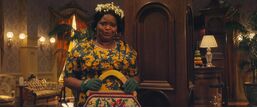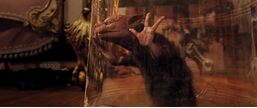When the protagonist's family left the church, the camera deliberately stopped on the profile of the heroine, the eldest daughter of the family, Thomas. The factor that symbolizes the collapse of the family begins with her. She is the only character with the most "reasonable" rebellious spirit and the most tragic end in the whole film. The following shot shows Thomas sitting at the back of the wagon as a group of Indians look at them before leaving the closed gated village. This paragraph directly points out the lack of status of the protagonist's family after being exiled - even the Indians who were squeezed and colonized in the future can stay in the plantation village, while the poor and low-key Puritan family People were kicked out of the circle and let themselves be under the shroud of nature. When it comes to "nature", the dense branches and forests of this film play an important role. It surrounds the protagonist's family from beginning to end and gradually devours them. I can't help but think of the empty hotel surrounded by snowstorms in "The Shining", how terrifying an isolated environment can have on a person's negative energy. As a Puritan, the protagonist should embrace the baptism of nature, but unexpectedly embraces death. I have to mention here the unique way of expressing the composition of the lens in this film. There are two most obvious ways of composition in the whole film: one is that the characters are in the lower left, and the rest of the picture is covered by a large area of darkness or forests, presenting a sense of unease and depression, as if the remaining 3/4 of the picture will emerge. What is it? Another is that the characters are centered at the bottom of the picture, and the rest of the picture is covered by trees, reflecting a sense of daze and powerlessness. The latter directly hints at the fate of the characters
View more about The Witches reviews











